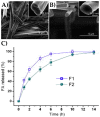Protein-Based Fiber Materials in Medicine: A Review
- PMID: 29932123
- PMCID: PMC6071022
- DOI: 10.3390/nano8070457
Protein-Based Fiber Materials in Medicine: A Review
Abstract
Fibrous materials have garnered much interest in the field of biomedical engineering due to their high surface-area-to-volume ratio, porosity, and tunability. Specifically, in the field of tissue engineering, fiber meshes have been used to create biomimetic nanostructures that allow for cell attachment, migration, and proliferation, to promote tissue regeneration and wound healing, as well as controllable drug delivery. In addition to the properties of conventional, synthetic polymer fibers, fibers made from natural polymers, such as proteins, can exhibit enhanced biocompatibility, bioactivity, and biodegradability. Of these proteins, keratin, collagen, silk, elastin, zein, and soy are some the most common used in fiber fabrication. The specific capabilities of these materials have been shown to vary based on their physical properties, as well as their fabrication method. To date, such fabrication methods include electrospinning, wet/dry jet spinning, dry spinning, centrifugal spinning, solution blowing, self-assembly, phase separation, and drawing. This review serves to provide a basic knowledge of these commonly utilized proteins and methods, as well as the fabricated fibers’ applications in biomedical research.
Keywords: biomaterials fabrication; drug delivery; medicine; nanofibers; protein; tissue engineering; wound healing.
Conflict of interest statement
The authors declare no conflict of interest.
Figures









References
-
- Vashisth P., Raghuwanshi N., Srivastava A.K., Singh H., Nagar H., Pruthi V. Ofloxacin loaded gellan/PVA nanofibers—Synthesis, characterization and evaluation of their gastroretentive/mucoadhesive drug delivery potential. Mater. Sci. Eng. C. 2017;71:611–619. doi: 10.1016/j.msec.2016.10.051. - DOI - PubMed
-
- Mutlu G., Calamak S., Ulubayram K., Guven E. Curcumin-loaded electrospun PHBV nanofibers as potential wound-dressing material. J. Drug Deliv. Sci. Technol. 2018;43:185–193. doi: 10.1016/j.jddst.2017.09.017. - DOI
Publication types
LinkOut - more resources
Full Text Sources
Other Literature Sources

